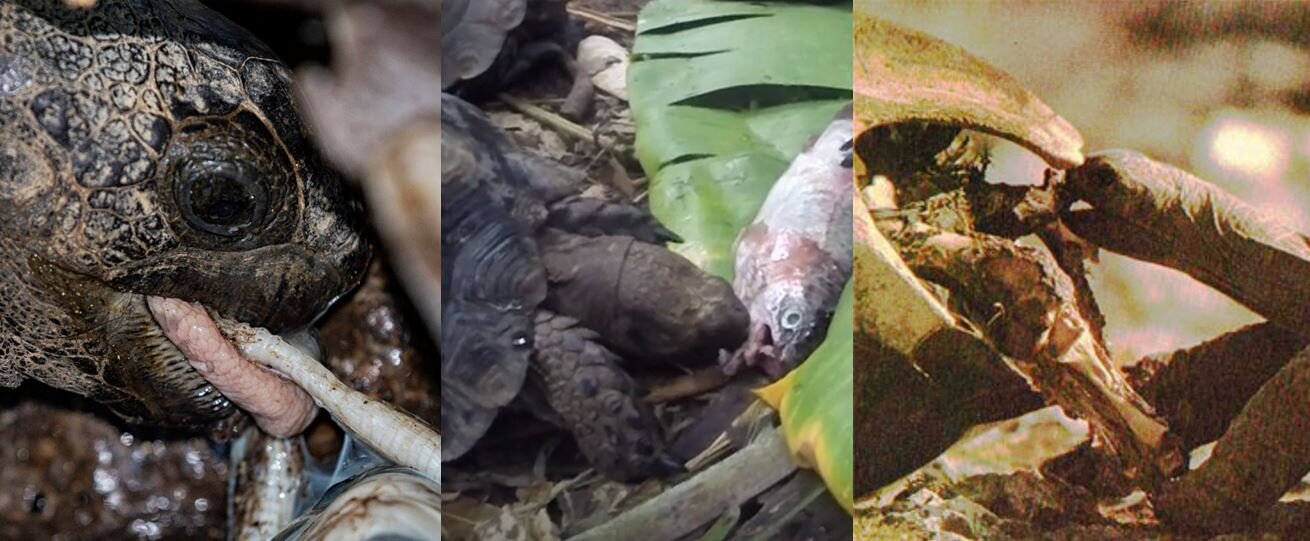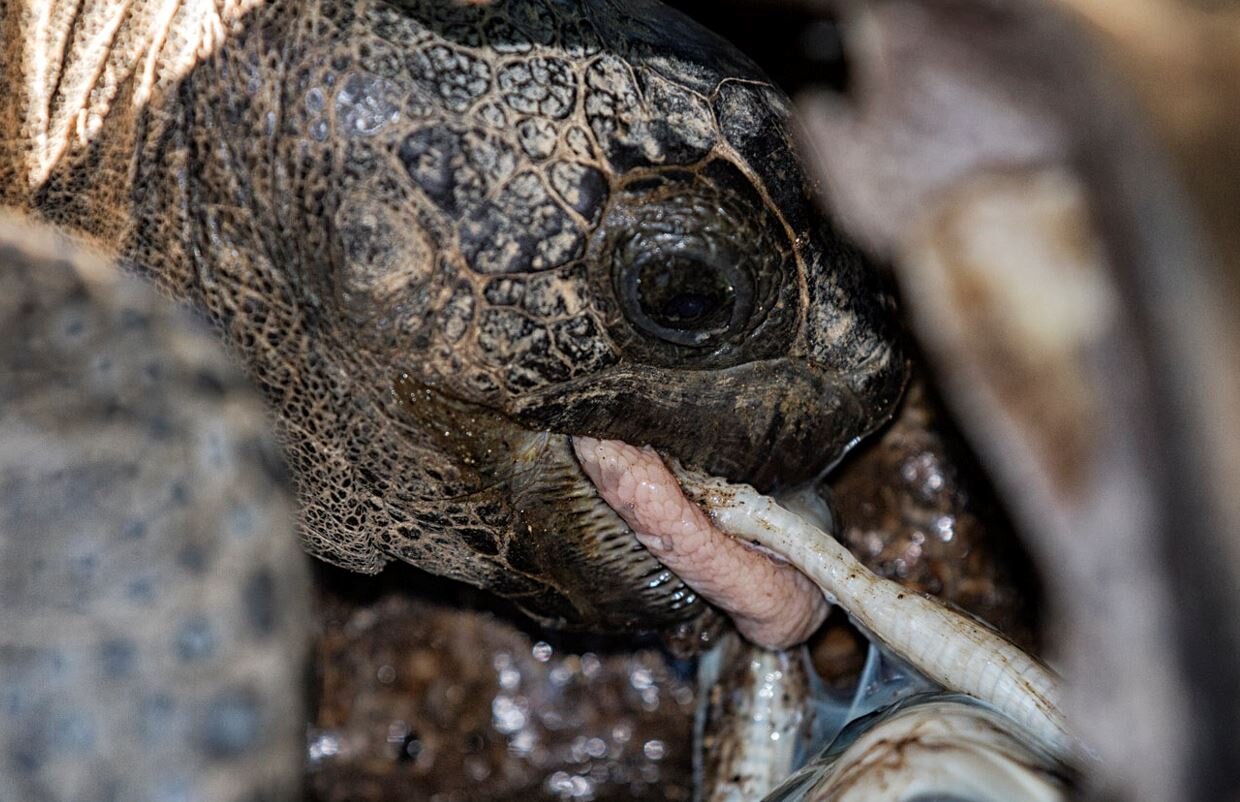“There’s no such thing as a pure herbivore”, the tortoise’s eye view…
Caption: tortoises and carrion, a montage (read on for more). Images: Dennis Hansen, Marwell Wildlife, David Attenborough.
As a regular reader with a good memory, you’ll no doubt recall the recent TetZoo article on carrion-eating in tortoises. Said article resulted in a fair bit of reader follow-up, both in the comments sections [OFFLINE AT THE TIME OF WRITING: this is a problem with our hosters that we’re trying to get fixed] and in emails and such, and in the interests of sharing what I learnt I give you… part two.
Here’s my plan for this article. It will start with stuff that people don’t consider that big a deal in terms of shock factor, but then will get worse, ending with something that you’ll likely find macabre and pretty horrid. You should regard my words here as a potential warning should you be at all squeamish or easily offended. That out of the way, we proceed.
The previous article focused, in part, on cases where tortoises (and Terrapene, a tortoise-like emydid turtle) have been observed eating the carcasses of mammals. It turns out – perhaps unsurprisingly – that tortoises are quite catholic in their predilection for vertebrate tissue, and will consume the flesh of the lowliest and most annoying of vertebrates, the fishes. Dan Garrick – Team Leader of the Herpetology Section at Marwell Zoo – kindly alerted me to a video where a group of Asian forest tortoises Manouria emys are happily consuming a deceased fish (a trout, given to them as a special treat). Go here for the video clip…
Caption: captive Asian forest tortoises (aka Asian brown tortoise or Burmese mountain tortoises) enjoy a fish carcass, and even appear to attempt to claim ownership of it. “It’s mine!”. Image: Marwell Wildlife.
It turns out the consumption of fish is known for other tortoise species and has been recorded in the technical literature. Mattea & Allain (2020) reported a case from 2019 in which a large Yellow-footed tortoise Chelonoidis denticulatus was observed consuming the carcass of Hoplias malabaricus, a wolf fish, in Manu National Park, Peru. The fish had apparently died as a consequence of the drying-up of a pool, and other deceased fish were present too. The authors noted that exploitation of fish carcasses has previously been reported for the Red-footed tortoise C. carbonaria (Mattea & Allain 2020). Incidentally, Manouria and Chelonoidis are well separated in tortoise phylogeny, so fish consumption can be considered a widespread trait in the group.
Caption: a wild Yellow-footed tortoise Chelonoidis denticulatus, photographed in between taking bites from a fish carcass. Chelonoidis tortoises often consume carrion. Image: Riccardo Mattea, from Mattea & Allain (2020).
Dead snakes and some not-so-forbidden cannibalism. Moving now to the consumption of reptiles, there are mentions here and there of tortoises scavenging on dead snakes (e.g., Gorzula & Señaris 1998, Mourthé & Casal 2017)… but then there’s the cannibalism. Many people interested in tortoises know, and have seen, David Attenborough’s photo in which an Aldabran giant tortoise Aldabrachelys gigantea is eating from the dried carcass of a conspecific (see the previous article). Tortoise expert Dennis Hansen has very kindly shared additional, more recent and substantially more detailed photos depicting the same behaviour. Seems that a dead Aldabran giant is seen as quite the desirable object by other members of its species, who move in to consume skin, muscle and internal organs too, mm-mm!
Caption: a wild Aldabran giant tortoise, photographed while consuming the trachea of a deceased conspecific. Image: Dennis Hansen.
As you can see from the images here, Dennis has even succeeded in filming the tortoises competing with mangrove crabs over access to a carcass. This is all exciting stuff which could mean that Aldabran giants – and maybe other island-dwelling tortoises too – are ecologically significant consumer of carrion. As I write this, I’m being lazy and not checking the literature… but I don’t think that any of this has been properly reported in the technical sense, and that further study is warranted. Dennis reports that he’s seen Aldabran giants consume the remains of deceased crabs, fishes, sea turtles and birds as well.
Caption: still from a video sequence in which an Aldabran giant tortoise and mangrove crab are squabbling over access to the carcass of another tortoise, the hindlimb of which is visible near the middle of frame. The full sequence can be observed here on Twitter. Image: Dennis Hansen.
It’s a general (but approximate) rule that the smaller-bodied members of some reptile groups are more inclined to be faunivorous or insectivorous than their larger cousins, and on this basis it’s safe to assume that giant tortoises are less inclined to eat carrion or other animal matter than are smaller species. But is this really true? Quite a few of the cases I’m covering here (including those in the previous article) concern big tortoises – indeed, the biggest of all the tortoises – so might it be that this isn’t accurate? Could some big or even giant tortoises be more faunivorous… or carnivorous, or whatever… than the smaller taxa?
A palaeoartistic tangent. Whenever we make these kinds of speculations, it’s understandable and predictable (and I don’t mean that in a negative way) that those artists who depict the animals of the past will be inspired, and show extinct animals indulging in similar behaviours. I’m pleased to say that my article on carrion-eating in tortoises inspired palaeoartist Hodari Nundu to produce the piece below. It depicts the giant Eurasian tortoise Megalochelys aiming to claim a carcass for itself, much to the displeasure of a giant short-faced hyena. Megalochelys is a fascinating animal for lots of reasons, but this isn’t the time to talk about it (if you support me at patreon you have the opportunity to see and read a fair bit about it already).
Caption: somewhere in southern Asia in the Pleistocene, the giant extinct tortoise Megalochelys and the hyaenid Pachycrocuta compete for the spoils. Image: Hodari Nundu, used with permission.
And here’s another relevant piece of art (though read on), this time by the amazing Julio Lacerda, and this time depicting the controversial horned turtled Meiolania about to scavenge on a fish. I don’t describe Meiolania as “controversial” because of its thoughts on gender politics or Marxism, but because there are some very disparate views on what it was like when it was alive. Was it a fully terrestrial tortoise analogue, was it amphibious, or was it fully aquatic? All have been suggested in recent years.
Caption: the horned, spiky-tailed meiolaniid turtle Meiolania prepares to consume a fish carcass. Image: Julio Lacerda, used with permission.
Meiolania, incidentally, is not a tortoise at all (and thus shouldn’t really be covered in this article), but more likely a stem-turtle, outside the cryptodire-pleurodire clade. I really should write more about meiolaniids some time, I’ve been meaning to for a few decades now. Anyway…
What about the consumption of mammal carcasses? I previously wrote about the eating of rodent remains by tortoises, but it turns out that there are also recorded cases in which Red-footed tortoises have been seen eating the carcasses of domestic horses – Mourthé & Casal (2017) published a photo of such an occurrence – in addition to those of agoutis and tamanduas. Bones of agouti and peccary have also been recovered from Red-footed tortoise scat (Mourthé & Casal 2017).
Caption: horse carcass with tortoise, an image from Mourthé & Casal (2017).
Finally, we come to the most curious and macabre cases I want to mention here. If tortoises are more than happy to eat vertebrate carcasses of all and every sort, and if they’re unashamed utilisers of large mammal carcass what, pray tell, might a tortoise or even a bunch of tortoises do if they encounter human remains? We know exactly what the answer is. I cited above a case in which Stefan Gorzula and J. Celsa Señaris reported – in their 1998 monograph on the herpetofauna of the Venezuelan Guayana – an observation in which captive Red-footed tortoises were hoping to consume a deceased snake. Inspired, they noted that members of the species “show a marked response to carrion” (Gorzula & Señaris 1998, p. 97) and went on to describe the following…
Pedro Piñate (MARNR*) informed SG of a similar, but very macabre, event in Amazonas State, when his cousin went to assist in uplifting the bodies of a pilot and passenger from a plane crash. The cousin reported that “dozens” of large Geochelone carbonaria** were feeding on the corpses that had lain in the forest for a couple of days.
* Ministerio del Ambiente y los Recursos Naturales Renovables (Venezuelan Department of Environment).
** An alternative taxonomic moniker for the species here termed Chelonoidis carbonaria. The traditional, highly inclusive version of Geochelone is polyphyletic and paraphyletic, and the name is now restricted to the southern Asian Indian star tortoise G. elegans and Burmese star tortoise G. platynota.
So, there you have it… large gangs of tortoises consuming the remains of people. Given how abundant people are, given how often there have been occasions in which deceased people have been left in the open (due to wars and territorial attacks, terrible accidents, ceremonial disposal of the dead, mass deaths due to disease and so on), it can be guaranteed that scavenging animals of all kinds have, over the centuries, had ample opportunity to exploit human remains as a source of food. In other words, you might argue that what’s been reported here isn’t at all surprising.
This seems like a good place to bring things to a close. Let us never look at tortoises in the same way again. For previous articles on tortoises, and on cases where animals ‘unexpectedly’ consume carrion or engage in acts of carnivory, see…
Tet Zoo picture of the day # 11 (Styracosaurus eats carrion), June 2007
Duiker, rhymes with biker, August 2008
Hippos are photographed biting a crocodile to death, November 2009
Lal the chicken-eating cow, December 2010
Turtles that eat bone, rocks and soil, and turtles that mine, April 2014
Predation and Corpse-Eating in Armadillos, September 2020
Tortoises as Consumers of Carrion, March 2021
Refs - -
Gorzula, S. & Señaris, J. C. 1998. Contribution to the herpetofauna of the Venezuelan Guayana I. A data base. Scientia Guaianae 8, 1-269.
Mattea, R. G. & Allain, S. J. R. 2020. Chelonoidis denticulatus (Yellow-footed tortoise) diet. Herpetological Review 51, 576.
Mourthé, Í. & Casal, A. C. 2017. Chelonoidis carbonaria (Red-footed tortoise). Scavenging behavior. Herpetological Review 48, 422-423.












